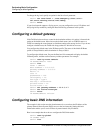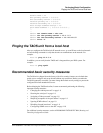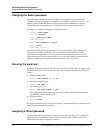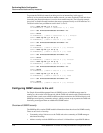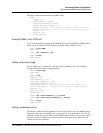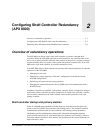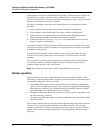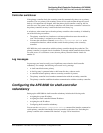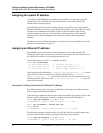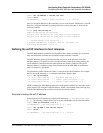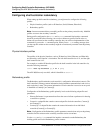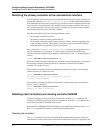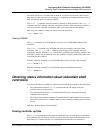
2-2 Preliminary May 9, 2000 APX 8000/MAX TNT/DSLTNT Physical Interface Configuration Guide
Configuring Shelf-Controller Redundancy (APX 8000)
Overview of redundancy operations
The controllers next elect the controller that will be primary. The election process is based on a
hierarchical list of complex criteria. The first criterion in the list is evaluated and if the
criterion is found to be true, one of the controllers is made primary. If the criterion is found to
be false, the next criterion in the list is evaluated.
Following is an example of the initial criteria that might be used to designate the primary
controller:
1 If one controller is missing, the existing (current) controller is made primary.
2 If one controller is not communicating, the current controller is made primary.
3 If both controllers are communicating, the controllers use the Redundancy profile’s
Primary-Preference setting to determine which controller is primary.
4 If Primary-Preference is set to No-Preference, the controller that last acted as the
primary controller is made primary.
If a primary controller is still not determined, additional criterion are evaluated. If all election
criteria fail to designate a primary controller, the controller with more resources (for example,
more RAM) is made primary.
If the criteria cannot determine which controller is primary, the system selects the right
controller (slot 42) to be primary and the left controller (slot 41) becomes the secondary
controller.
Once a controller is elected as primary, the primary controller proceeds to load operational
code. When the primary is finished loading its code, the secondary controller loads its
operational image and gets a copy of the profiles.
Note: Both controllers must load the same boot and operational code version.
Normal operation
During normal operation, the two shelf controllers communicate with each other over the
packet bus in a back-and-forth heartbeat, exchanging context information. The status lights on
each controller indicate the following activities:
• The heartbeat (HRT) status light on each controller visually indicates that the heartbeat
protocol is active by blinking on and off every 4 seconds in a regular pattern that alternates
between the two controllers. In a TAOS unit that has only one shelf controller, the HRT
status light flashes on for 40 milliseconds every 4 seconds.
• The primary (PRI) status light on each controller is lit if the controller is the primary and is
off if the controller is secondary.
• The operational (OPR) status light is lit when the operational code is successfully loaded
onto the controller.
The secondary controller does not perform controller operations unless the primary controller
resets or fails, or if you change the functionality of the shelf controllers. The secondary
controller’s main role is to monitor the primary and be ready to take over primary controller
functions. The secondary controller maintains the current configuration and the fatal-error
history log.



